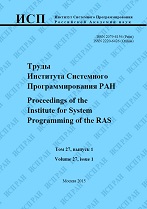|
This article is cited in 1 scientific paper (total in 1 paper)
Model of problem-oriented cloud computing environment
G. I. Radchenko
South Ural State University
Abstract:
For efficient use of high-performance computing resources while implementing Computational Science methods for the study of physical, biological and social problems one can use problem-oriented distributed computing environments approach. They provide users with transparent access to the solution of specific classes of applications based on the available computing resources. To increase the effectiveness of such environments, one must use problem-oriented planning methods, which use the information about the subject area for predicting computing problems performance for optimal tasks planning and allocation. In the article the models of the subject area and problem-oriented cloud computing environment, focused on supporting the development of new problem-oriented scheduling algorithms are presented. Subject area P is defined as an ordered triple, consisting of a set of basic information objects B , the set of information object classes C and a set of functions defined over C . The task-oriented cloud computing environment can be defined as an ordered quadruple consisting of the set of nodes of a computer system N ; a set of network connections E ; a set of virtual machines images M , the basic subject area P . It should be required that within a problem-oriented computing environment the following functions for the prediction of the task execution, depending on the values of the input parameters for each class of problems were identified: the estimation of the amount of output data when a certain set of input parameters is given; the evaluation function of task execution time, given certain input parameters on the machine with the specified performance characteristics vector. Since it is impossible to estimate the time of the task execution with a perfect accuracy, task runtime evaluation should be modeled as a random variable. The provided model allows tasks execution time and output parameters volume evaluation through the collection, storage and analysis of statistics for all problems, executed in the environment.
Keywords:
cloud computing, computing environment model, distributed computing system, problem-oriented computing environment.
Citation:
G. I. Radchenko, “Model of problem-oriented cloud computing environment”, Proceedings of ISP RAS, 27:6 (2015), 275–284
Linking options:
https://www.mathnet.ru/eng/tisp197 https://www.mathnet.ru/eng/tisp/v27/i6/p275
|

| Statistics & downloads: |
| Abstract page: | 171 | | Full-text PDF : | 52 | | References: | 31 |
|




 Contact us:
Contact us: Terms of Use
Terms of Use
 Registration to the website
Registration to the website Logotypes
Logotypes








 Citation in format
Citation in format 
